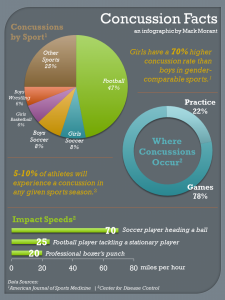Recent ly media attention has brought the seriousness of concussion to the forefront of public eye. The subject of concisions and the long and short term effects is a concern at every level of play; from grammar school, high school, college and even pro sports.
ly media attention has brought the seriousness of concussion to the forefront of public eye. The subject of concisions and the long and short term effects is a concern at every level of play; from grammar school, high school, college and even pro sports.
In the past, “getting your Bell Rung” was not considered a setback. A broken or dislocated bone can be quite obvious and in most cases a player physically cannot return to play however, a concussed athlete may physically be able to return to play without any pain. You can’t see a concussion.
New Jersey passed a Youth Sports Concussion Safety Law in 2010. It requires all public and non public schools grades K-12 to establish a head injury and concussion training program, as well as a written policy for prevention and treatment of concussions
WHAT IS A CONCUSSION? A concussion is an injury to the brain caused by impact. Even a mild blow can cause a concussion. A player does not necessarily have to be knocked unconscious to cause a severe concussion. It may be the manner in which an athlete is hit which can cause the injury. Side impact hits, impact under the chin or to the jaw, can be the most vulnerable areas.
THE FACTS
According to the CDC (Center for Disease Control)
- A concussion is a brain injury.
- All concussions are serious.
- Concussions can occur without loss of consciousness.
- Concussions can occur in any sport.
Signs of a Concussion
- A Player does not know what to do on the court or field and may forget their position
- Can’t remembered when the event began, how long it has been in progress, the score, or the opponent
- Can’t remember being injured
- Shows behavior or personality changes
- Does not remember events prior to the injury
- Nausea or vomiting
- Balance problems or dizziness
- Blurry or double or blurry vision
- Headache
- Sensitivity to light & noise
- Feeling sluggish, in a haze, fog, or groggy
- Difficulty concentrating
- Short term and long term memory problems
- Confusion
- Does not “feel right” Losses normal coordination
- Can’t answers questions with a normal response time
- Loss of consciousness (even briefly)
Recovery/Treatment-Physical & Mental Rest
Physical Rest:
- No sports
- No Physical Education classes oe exercise
- No weight training or conditioning drills
- No running or jumping
Mental Rest:
- No reading or writing
- May require missing school
- No TV or computer games
- No computer
- Avoid bright lights and loud noises
Reduce the Risk- Baseline Test
Baseline concussion tests
Computerized concussion testing can be administered and are extremely helpful diagnosing and assessing return to play readiness. The tests are administered to each athlete before a concussion occurs. Memory, reaction time, brain processing speed, balance and postural stability are tested post injury, another test administered at the time of injury. The results are then compared to measure the athlete’s brain function. This helps improve concussion care and make return-to-play assessment.
Reduce the Risk-Proper Equipment
Recent research has shown that a custom made mouth guard fitted by your child’s dentist might significantly reduce the risk of concussion. Parents and coaches should inspect mouth pieces regularly throughout the season for wear and tear.
In addition to the mouth piece, it is extremely important that your child’s chin strap is adjusted properly, sized correctly and each helmet is certified and reconditioned every year.
Your pediatrician should be able to help you check your child’s helmet for a proper fit.
Return to Play
Return to play guidelines may vary, but all agree that an athlete should be symptom free at a minimum before returning to play.
- Slowly increase non-contact physical activity when symptom free.
- Return to contact sports recommendations rage for 7-10 days after the first day you are you are completely symptom free or have returned to baseline. When in doubt, check with your pediatrician.
Second Impact Syndrome
Second Impact Syndrome is when a player sustains an additional concussion or brain trauma before recovering from the initial head injury. Second impact syndrome is extremely serious; it can be fatal or cause permanent brain damage.
Second impact can increase brain swelling and increased intracranial pressure, when this occurs it may be difficult or impossible to control. Follow the Return to Play Guidelines to limit the risk of Second Impact Syndrome.
Remember you are the parent. When your child returns to play is up to you and your doctor. Consult your pediatrician or neurologist for a full exam
